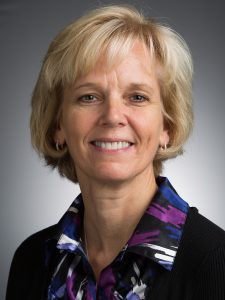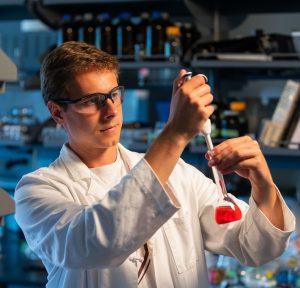A Big Grant to Tackle a Microscopic Problem

Microplastics — tiny fragments of plastic materials that have shattered into microscopic size pieces over time — have been making headlines in recent years for the sheer amount of it being found in all parts of the world. A brief glance at the headlines shows growing concerns about the concentration of this pervasive form of pollution in our oceans, our crops, and even our bodies. However, while concern about the implications of microplastics has only cropped up in the last two decades, the pollutant itself is anything but new.
“We knew about microplastics quite a long while ago,” says Julie Peller, Ph.D., professor of chemistry at Valparaiso University. “For whatever reason, it just didn’t draw the attention it warranted.”
Professor Peller has been interested in how potentially hazardous materials break down in nature since her time as a student studying organic compounds like pharmaceuticals, pesticides, and other contaminants with a troubling pattern of finding their way into water systems. Over time, her interest shifted to the issues around the non-decomposing plastic problem.
“Plastic isn’t nature compatible, as I call it,” Professor Peller says. ““It doesn’t break down chemically or decompose like other materials, but fragments into smaller pieces.”
In 2020, The National Science Foundation (NSF) awarded Professor Peller and her team a grant of almost $300,000 to research the long-term fate of microplastics in our environment. After discussing her project with an NSF official in 2021, she was encouraged to apply for another grant to continue the project’s funding. Despite having only two weeks to put together her proposal before the deadline, Professor Peller and her collaborator successfully made their case.
“I believe we worked more or less nonstop for about 10 days,” Professor Peller recalls. “I was very happy to find out we’d been named the recipients. The more we work on this project, the more questions we seem to generate.”

Professor Peller, along with her collaborators and student researchers at Valpo, have been trying to uncover just how microplastics could continue to change in the environment from this point forward. One key to uncovering just what tomorrow will bring is radiation chemistry, the process of bombarding small samples with gamma radiation in order to speed up the aging process for observation.
“What happens in nature over decades, or even centuries, we can turn into hours or days,” Professor Peller says. “It’s like putting it all on fast-forward.”
The continuation of NSF funding through this grant — which will provide Valparaiso University with over $300,000 over the course of three years upon the completion of the 2020 grant — will allow Professor Peller to continue to purchase necessary equipment for her experiments, communicate her findings with the scientific community through conference attendance and papers, and support the student researchers assisting her with the project year-round.
Figuring out how these components may continue to change may fill an important gap in our understanding of microplastics and how they could impact the natural world, including the effect they may have on human beings.
“It’s a great question, and we don’t have great answers to it yet,” Professor Peller says, adding that a growing body of evidence in the health science sector has found microplastics in our food, our drink, and even in our bloodstreams.”
Another cause for concern is the immense increase in plastic products being consumed around the world, with around half of all plastics ever manufactured being created within the last decade.
“We all have these in our bodies,” Professor Peller says. “My concern is that, given how much we’ve been manufacturing in the last decade, we are exposing today’s children to far more of this than we as adults were ever exposed to.”
As a long-term problem, the microplastic situation will require the assistance of future experts ready to go into the field, and Professor Peller’s project is fostering the growth of such experts. Valparaiso alumni have worked for up to all four years of their college career on the project, getting their names on scientific papers and a major leg-up as they continue in the field. Joe Castleman ’23 found that the two years he spent working on the project has had a profound impact on his future career goals.
“I was going to work in health care or medicine, but this experience has increased my interest in doing research and investigating how environmental factors impact human health,” Joe says. “I’m so thankful for the opportunity I’ve had at Valpo to do so much research. Working on this project has led to me getting to go do this micro and nano plastic research at California State University Long Beach and Notre Dame, along with the opportunity to present my work at various Valpo symposiums.”
For Professor Peller, working with students is a highlight of the project.
“I’ve had students over the last few years that have just been incredible,” Professor Peller says. “They’re dedicated to it, they’re interested in it, and they’re generating questions and ideas about what we’re doing with the project.”
Professor Peller and her team’s work on microplastics is just one of the many ways the Valparaiso University chemistry department is making a real-world impact and giving students the opportunity to boost their STEM careers. For more information on the faculty, courses, and success stories to come from the department, visit valpo.edu/chemistry.
